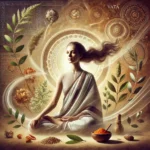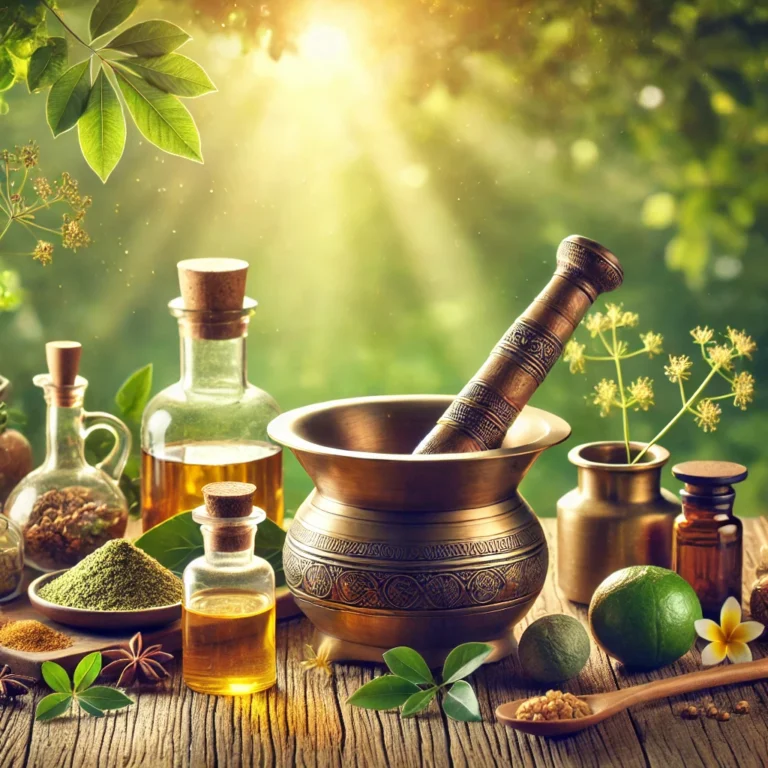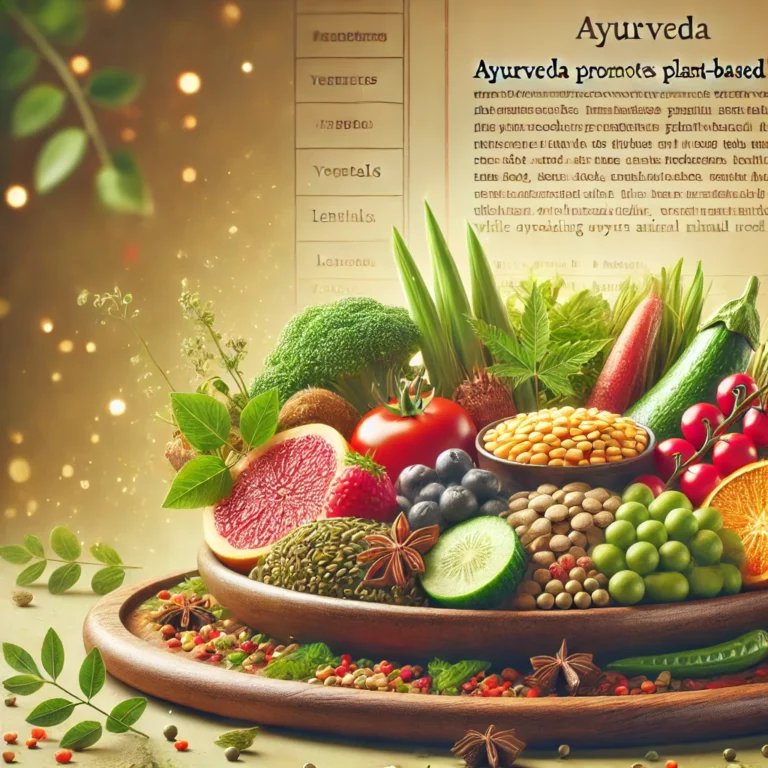Yoga and Pranayama for Balancing Vata Dosha
Yoga and Pranayama are essential for grounding Vata energy and promoting stability in the body and mind. Since Vata is mobile, dry, and erratic in nature, the best yoga practices include slow, steady, grounding poses and breathwork techniques that encourage deep relaxation.
Best Yoga Asanas for Vata Balance
1.Vrikshasana (Tree Pose)
- Benefits: Encourages grounding, enhances balance, and stabilizes an overactive mind.
- How to Perform: Stand tall, place one foot on the opposite thigh, bring palms together, and focus on deep breathing.
2.Tadasana (Mountain Pose)
- Benefits: Promotes stability, corrects posture, and strengthens legs.
- How to Perform: Stand with feet hip-width apart, engage core, and extend arms overhead.
3.Vajrasana (Thunderbolt Pose)
- Benefits: Supports digestion, strengthens the lower body, and pacifies nervous tension.
- How to Perform: Kneel with feet together, sit back on heels, and keep the spine erect.
4.Balasana (Child’s Pose)
- Benefits: Soothes the nervous system, relieves stress, and promotes deep relaxation.
- How to Perform: Sit on heels, extend arms forward, rest forehead on the ground, and breathe deeply.
5.Supta Baddha Konasana (Reclined Butterfly Pose)
- Benefits: Opens the hips, relaxes the lower abdomen, and relieves anxiety.
- How to Perform: Lie on your back, bring the soles of your feet together, and let knees drop outward.
6.Paschimottanasana (Seated Forward Bend)
- Benefits: Encourages introspection, stretches the spine, and calms the mind.
- How to Perform: Sit with legs extended, reach forward, and rest forehead on knees.
7.Setu Bandhasana (Bridge Pose)
- Benefits: Strengthens the spine, calms the brain, and regulates energy flow.
- How to Perform: Lie on your back, bend knees, lift hips, and clasp hands underneath.
Best Pranayama for Vata Dosha
1.Nadi Shodhana (Alternate Nostril Breathing)
- Benefits: Balances the nervous system, reduces anxiety, and promotes mental clarity.
- How to Perform: Use the right thumb to close the right nostril, inhale through the left nostril, close the left nostril, and exhale through the right nostril. Repeat on the other side.
2.Bhramari Pranayama (Humming Bee Breath)
- Benefits: Reduces mental restlessness, induces deep relaxation, and soothes the nervous system.
- How to Perform: Close ears with fingers, take a deep breath in, and exhale while making a humming sound.
3.Ujjayi Pranayama (Victorious Breath)
- Benefits: Improves oxygen flow, regulates breath, and enhances stability.
- How to Perform: Inhale deeply through the nose while slightly constricting the throat, and exhale with an audible sound.
4.Anulom Vilom (Alternate Nostril Breathing Without Retention)
- Benefits: Enhances oxygen flow, calms Vata-induced anxiety, and stabilizes energy.
- How to Perform: Breathe through one nostril at a time in a rhythmic flow without holding the breath.
How to Incorporate Yoga and Pranayama into a Daily Routine
- Morning: Start your day with 10 minutes of gentle stretching and 5-10 minutes of Nadi Shodhana to center your energy.
- Afternoon Break: If you feel restless, take a break with Balasana or Supta Baddha Konasana to restore calmness.
- Evening Wind-Down: Before bed, perform Bhramari Pranayama and Vajrasana to release built-up tension and promote restful sleep.
Best Ayurvedic Herbs and Concoctions for Balancing Vata Dosha
Ayurveda prescribes specific herbs and formulations to stabilize Vata dosha by nourishing tissues, supporting digestion, and calming the nervous system. Below are some powerful Ayurvedic herbs and concoctions, along with their recipes, recommended dosage, and usage guidelines.
1. Ashwagandha Milk (Stress-Relief & Nervous System Support)
- Who should take it? Individuals experiencing stress, insomnia, anxiety, and nervous system imbalances.
- Who should not take it? Those with high Pitta conditions (excess body heat) or hyperthyroidism.
- When to take? 30 minutes before bedtime for deep relaxation and sound sleep.
- Dosage: 1 cup warm milk with 1 tsp Ashwagandha powder.
- Recipe:
- 1 cup warm cow/almond milk
- 1 tsp Ashwagandha powder
- 1/2 tsp cardamom powder
- 1/2 tsp ghee
- Mix well and drink warm.
- Sutra Reference: “Ashwagandha balya rasayanam” (Charaka Samhita, Chikitsa Sthana 1.3) – Ashwagandha is a potent rejuvenator and strength-promoting herb.
2. Triphala Ghee (Digestive & Detox Tonic)
- Who should take it? Those suffering from constipation, bloating, and sluggish digestion.
- Who should not take it? Those experiencing diarrhea or loose stools.
- When to take? Before bedtime for overnight detoxification.
- Dosage: 1 tsp Triphala powder mixed with 1 tsp ghee.
- Recipe:
- 1 tsp Triphala powder
- 1 tsp warm ghee
- Mix and consume before bed.
- Sutra Reference: “Triphala vata pittakaphanilam” (Charaka Samhita, Sutrasthana 25.40) – Triphala balances all three doshas, supporting digestion and detoxification.
3. Dashamoola Tea (Joint & Nervous System Support)
- Who should take it? People experiencing joint pain, nervous weakness, and excessive body stiffness.
- Who should not take it? Pregnant women and individuals with excessive mucus accumulation.
- When to take? Twice daily (morning and evening).
- Dosage: 1 tsp Dashamoola powder boiled in 2 cups water.
- Recipe:
- 1 tsp Dashamoola powder
- 2 cups water
- Boil for 10 minutes, strain, and drink warm.
- Sutra Reference: “Dashamoola balya shoolahara” (Charaka Samhita, Sutrasthana 4.11) – Dashamoola is strengthening and effective in pain relief.
4. Nutmeg & Warm Milk (Deep Sleep & Relaxation Tonic)
- Who should take it? Individuals struggling with insomnia, stress, and overthinking.
- Who should not take it? Those with sluggish digestion or those prone to excessive sleepiness.
- When to take? 30 minutes before bedtime.
- Dosage: 1/4 tsp nutmeg powder in warm milk.
- Recipe:
- 1 cup warm milk
- 1/4 tsp nutmeg powder
- 1/2 tsp honey
- Mix well and drink before sleep.
- Sutra Reference: “Jatiphala nidrajananam” (Charaka Samhita, Sutrasthana 5.10) – Nutmeg induces restful sleep and soothes the nervous system.
5. Licorice Tea (Soothing the Digestive System & Calming the Mind)
- Who should take it? Individuals with dry throat, irregular digestion, and chronic stress.
- Who should not take it? Those with high blood pressure or excessive Kapha (mucus accumulation).
- When to take? Mid-afternoon or before bed.
- Dosage: 1 cup warm tea with 1/2 tsp licorice root powder.
- Recipe:
- 1/2 tsp licorice root powder
- 1 cup warm water
- Boil for 5 minutes, strain, and drink.
- Sutra Reference: “Yashtimadhu vata pittahara” (Charaka Samhita, Chikitsa Sthana 1.3) – Licorice balances Vata and Pitta while soothing digestion.
6. Mahanarayan Oil (Joint & Muscle Pain Relief Massage)
- Who should use it? People suffering from joint pain, stiffness, and chronic fatigue.
- Who should not use it? Those with extreme sensitivity to oils or open wounds.
- When to apply? Before bath or before bedtime.
- How to use?
- Warm a few drops of Mahanarayan oil.
- Massage affected areas gently in circular motions.
- Let it absorb for 20 minutes before rinsing with warm water.
- Sutra Reference: “Tailam snehanam vataharam” (Charaka Samhita, Sutrasthana 5.85) – Oil application pacifies Vata and nourishes the body.
How to Incorporate These Concoctions into Your Daily Routine
- Morning Routine: Triphala Ghee on an empty stomach, followed by Licorice Tea mid-morning.
- Midday Routine: Dashamoola Tea post-lunch to support digestion and relieve tension.
- Evening Routine: Warm Ashwagandha Milk or Nutmeg Milk before bed to enhance relaxation and sleep.
- Nighttime Routine: Mahanarayan oil massage for muscle relaxation and pain relief.




